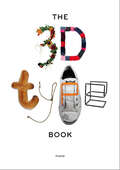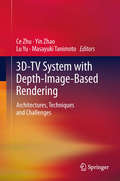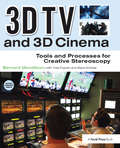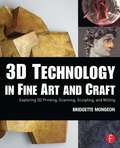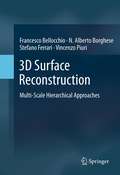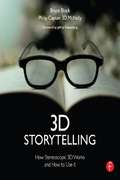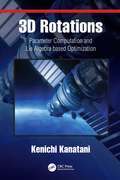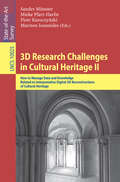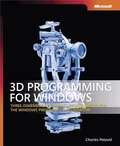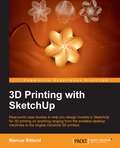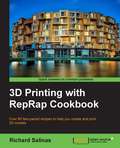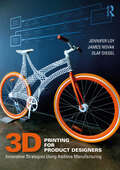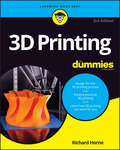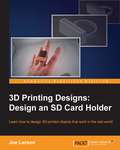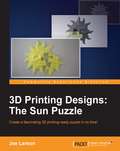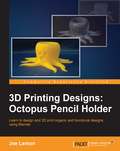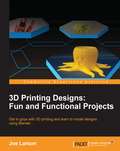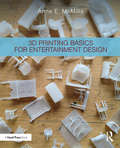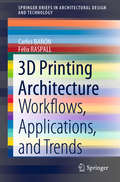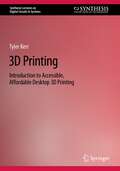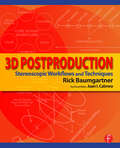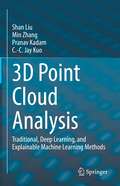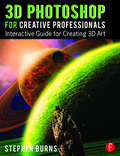- Table View
- List View
The 3D Type Book
by FL@33This book is the most comprehensive showcase of three-dimensional letterforms ever written, featuring over 1,300 images of more than 300 projects by more than 160 emerging talents and established individuals and studios.Contributors include Sagmeister Inc, Vaughan Oliver, Milton Glaser, Alvin Lustig, Louis Danziger, Roger Excoffon, Paul Elliman, Marian Bantjes, Geoff Kaplan, Clotilde Olyff, Italo Lupi, Marion Bataille, Antoine+Manuel, Frost*Design, Mervyn Kurlansky, Non-Format, Oded Ezer, Rowland Scherman, Post Typography, Rinzen, Underware’s Type Workshop, J. Kyle Daevel, Ji Lee, Pleaseletmedesign, and Strange Attractors Design.As well as pioneering milestones from as far back as the 1940s, this book focuses on recent and brand new typographic projects. 3D type specialist Andrew Byrom explains the context and motivation behind these innovative works in an insightful foreword. Please visit the dedicated website 3d-type.com for additional info.
The 3D Type Book
by FL@33This book is the most comprehensive showcase of three-dimensional letterforms ever written, featuring over 1,300 images of more than 300 projects by more than 160 emerging talents and established individuals and studios.Contributors include Sagmeister Inc, Vaughan Oliver, Milton Glaser, Alvin Lustig, Louis Danziger, Roger Excoffon, Paul Elliman, Marian Bantjes, Geoff Kaplan, Clotilde Olyff, Italo Lupi, Marion Bataille, Antoine+Manuel, Frost*Design, Mervyn Kurlansky, Non-Format, Oded Ezer, Rowland Scherman, Post Typography, Rinzen, Underware’s Type Workshop, J. Kyle Daevel, Ji Lee, Pleaseletmedesign, and Strange Attractors Design.As well as pioneering milestones from as far back as the 1940s, this book focuses on recent and brand new typographic projects. 3D type specialist Andrew Byrom explains the context and motivation behind these innovative works in an insightful foreword. Please visit the dedicated website 3d-type.com for additional info.
3D-TV System with Depth-Image-Based Rendering: Architectures, Techniques and Challenges
by Masayuki Tanimoto Ce Zhu Lu Yu Yin ZhaoRiding on the success of 3D cinema blockbusters and advances in stereoscopic display technology, 3D video applications have gathered momentum in recent years. 3D-TV System with Depth-Image-Based Rendering: Architectures, Techniques and Challenges surveys depth-image-based 3D-TV systems, which are expected to be put into applications in the near future. Depth-image-based rendering (DIBR) significantly enhances the 3D visual experience compared to stereoscopic systems currently in use. DIBR techniques make it possible to generate additional viewpoints using 3D warping techniques to adjust the perceived depth of stereoscopic videos and provide for auto-stereoscopic displays that do not require glasses for viewing the 3D image. The material includes a technical review and literature survey of components and complete systems, solutions for technical issues, and implementation of prototypes. The book is organized into four sections: System Overview, Content Generation, Data Compression and Transmission, and 3D Visualization and Quality Assessment. This book will benefit researchers, developers, engineers, and innovators, as well as advanced undergraduate and graduate students working in relevant areas.
3D TV and 3D Cinema: Tools and Processes for Creative Stereoscopy
by Bernard MendiburuThis book helps you master the technical requirements of shooting 3D stereoscopic images. This title defines the concept of a professional 3D camera system and describes what features are required to make a successful unit to keep your production on schedule and on budget.
3D Technology in Fine Art and Craft: Exploring 3D Printing, Scanning, Sculpting and Milling
by Bridgette MongeonThe possibilities for creation are endless with 3D printing, sculpting, scanning, and milling, and new opportunities are popping up faster than artists can keep up with them. 3D Technology in Fine Art and Craft takes the mystery out of these exciting new processes by demonstrating how to navigate their digital components and showing their real world applications. Artists will learn to incorporate these new technologies into their studio work and see their creations come to life in a physical form never before possible. Featuring a primer on 3D basics for beginners,interviews, tutorials, and artwork from over 80 artists, intellectual property rights information, and a comprehensive companion website, this book is your field guide to exploring the exhilarating new world of 3D. Follow step-by-step photos and tutorials outlining the techniques, methodologies, and finished products of master artists who have employed 3D technology in new and inventive ways Learn how to enlarge, reduce, and repurpose existing artwork and create virtual pieces in physical forms through a variety of mediums Research your options with an accessible list of pros and cons of the various software, 3D printers, scanners, milling machines, and vendors that provide services in 3D technology Listen to podcasts with the artists and learn more tips and tricks through the book's website at www.digitalsculpting.net
3D Surface Reconstruction: Multi-Scale Hierarchical Approaches
by Vincenzo Piuri Francesco Bellocchio N. Alberto Borghese Stefano Ferrari3D Surface Reconstruction: Multi-Scale Hierarchical Approaches presents methods to model 3D objects in an incremental way so as to capture more finer details at each step. The configuration of the model parameters, the rationale and solutions are described and discussed in detail so the reader has a strong understanding of the methodology. Modeling starts from data captured by 3D digitizers and makes the process even more clear and engaging. Innovative approaches, based on two popular machine learning paradigms, namely Radial Basis Functions and the Support Vector Machines, are also introduced. These paradigms are innovatively extended to a multi-scale incremental structure, based on a hierarchical scheme. The resulting approaches allow readers to achieve high accuracy with limited computational complexity, and makes the approaches appropriate for online, real-time operation. Applications can be found in any domain in which regression is required. 3D Surface Reconstruction: Multi-Scale Hierarchical Approaches is designed as a secondary text book or reference for advanced-level students and researchers in computer science. This book also targets practitioners working in computer vision or machine learning related fields.
3D Storytelling: How Stereoscopic 3D Works and How to Use It
by Bruce Block Philip Mcnally3D Storytelling is the ultimate guide for directors, cinematographers, producers, and designers of stereoscopic 3D movies and videos. With an emphasis on the aesthetic over the technical, this book is an essential foundation for showing you how to use 3D creatively to tell a story. Hollywood producer Bruce Block and Dreamworks stereoscopic supervisor Philip Captain 3D McNally blend their vast real-world experience and teaching skills to help you learn how to:* Think in 3D* Integrate 3D design into your script or story* Direct and design the 3D depth of your shots* Use stereoscopic windows* Work with the depth cues in 3D* Create a comfortable viewing experience for the audience* Plan editing and directorial considerations for 3D* Understand closed, open, and unstable 3D spaceBrimming with practical information that can be immediately applied to your 3D production, the book also features interviews with some of the industry’s leading stereographers, as well as 3D diagrams and photographs that illustrate how 3D works, how it can be controlled in production, and how 3D can be used to tell a story.
3D Rotations: Parameter Computation and Lie Algebra based Optimization
by Kenichi Kanatani3D rotation analysis is widely encountered in everyday problems thanks to the development of computers. Sensing 3D using cameras and sensors, analyzing and modeling 3D for computer vision and computer graphics, and controlling and simulating robot motion all require 3D rotation computation. This book focuses on the computational analysis of 3D rotation, rather than classical motion analysis. It regards noise as random variables and models their probability distributions. It also pursues statistically optimal computation for maximizing the expected accuracy, as is typical of nonlinear optimization. All concepts are illustrated using computer vision applications as examples. Mathematically, the set of all 3D rotations forms a group denoted by SO(3). Exploiting this group property, we obtain an optimal solution analytical or numerically, depending on the problem. Our numerical scheme, which we call the "Lie algebra method," is based on the Lie group structure of SO(3). This book also proposes computing projects for readers who want to code the theories presented in this book, describing necessary 3D simulation setting as well as providing real GPS 3D measurement data. To help readers not very familiar with abstract mathematics, a brief overview of quaternion algebra, matrix analysis, Lie groups, and Lie algebras is provided as Appendix at the end of the volume.
3D Research Challenges in Cultural Heritage III: Complexity and Quality in Digitisation (Lecture Notes in Computer Science #13125)
by Marinos Ioannides Petros PatiasThis open access book presents a collection of papers focusing on current 3D research challenges in the domain of digital cultural heritage. 3D technologies find considerable use within the field of cultural heritage at the beginning of the 21st century, for example in the areas of data acquisition, modeling, archiving in local repositories, harvesting in digital libraries and their long-term preservation. This volume put emphasis on a number of challenges facing 3D research in the 2D/3D digitization of tangible objects and their transformation to digital/virtual/memory twins; the interplay of geometry, semantics and the recovery and management of knowledge in digital cultural heritage; the handling of 3D data via the Cloud on the Internet and mobile devices; the presentation of cultural heritage content in 3D to the general public; and the 3D reproduction of cultural heritage objects from virtual to real.
3D Research Challenges in Cultural Heritage II: How to Manage Data and Knowledge Related to Interpretative Digital 3D Reconstructions of Cultural Heritage (Lecture Notes in Computer Science #10025)
by Sander Münster Mieke Pfarr-Harfst Piotr Kuroczyński Marinos IoannidesThis book reflects a current state of the art and future perspectives of Digital Heritage focusing on not interpretative reconstruction and including as well as bridging practical and theoretical perspectives, strategies and approaches. Comprehensive key challenges are related to knowledge transfer and management as well as data handling within a interpretative digital reconstruction of Cultural Heritage including aspects of digital object creation, sustainability, accessibility, documentation, presentation, preservation and more general scientific compatibility. The three parts of the book provide an overview of a scope of usage scenarios, a current state of infrastructures as digital libraries, information repositories for an interpretative reconstruction of Cultural Heritage; highlight strategies, practices and principles currently used to ensure compatibility, reusability and sustainability of data objects and related knowledge within a 3D reconstruction work process on a day to day work basis; and show innovative concepts for the exchange, publishing and management of 3D objects and for inherit knowledge about data, workflows and semantic structures.
3D Programming for Windows®
by Charles PetzoldGet a focused introduction to programming 3D graphics with the Windows Presentation Foundation 3D API. Complementing his book Applications = Code + Markup, award-winning author Charles Petzold builds on XAML essentials, teaching you how to display and animate 3D graphics under the Microsoft .NET Framework 3.0 and Windows Vista. You'll get expert guidance and code samples in XAML and Microsoft Visual C#-- helping you master the skills you need to create high-fidelity user interfaces. Discover how to: Define complex 3D objects with triangle meshes Enhance the illumination of 3D surfaces with light and shading effects Color 3D figures with gradients, bitmaps, and drawings Add animation with transforms and vertex manipulation Represent linear, affine, and camera transforms by using matrices Calculate vector angles, angles of rotation, and axes of rotation Generate triangle meshes efficiently by using C# code Express rotation by using quaternion computation Provide a user interface for manipulating and drawing 3D figures PLUS--Get Visual C# and XAML code samples on the Web
3D Printing with SketchUp
by Marcus RitlandThis book is a practical tutorial, packed with real-world case studies to help you design models that print right the first time. If you are familiar with SketchUp and want to print the models you've designed, then this book is ideal for you. You don't need any experience in 3D printing; however, SketchUp beginners will require a companion book or video training series to teach them the basic SketchUp skills.
3D Printing with RepRap Cookbook
by Richard SalinasA systematic guide consisting of over 100 recipes which focus on helping you understand the process of 3D printing using RepRap machines. The book aims at providing professionals with a series of working recipes to help make their fuzzy notions into real, saleable projects/objects using 3D printing technology. This book is for novice designers and artists who own a RepRap-based 3D printer, have fundamental knowledge of its working, and who desire to gain better mastery of the printing process. For the more experienced user, it will provide a handy visual resource, with side-by-side comparisons of the two most popular slicers, Skeinforge and Slic3r. A basic understanding of designing and modeling principles and elementary knowledge of digital modeling would be a plus.
3D Printing for Product Designers: Innovative Strategies Using Additive Manufacturing
by Jennifer Loy James Novak Olaf Diegel3D Printing for Product Designers closes the gap between the rhetoric of 3D printing in manufacturing and the reality for product designers. It provides practical strategies to support the adoption and integration of 3D printing into professional practice. 3D printing has evolved over the last decade into a practical proposition for manufacturing, opening up innovative opportunities for product designers. From its foundations in rapid prototyping, additive manufacturing has developed into a range of technologies suitable for end-use products. This book shows you how to evaluate and sensitively understand people, process, and products and demonstrates how solutions for working with additive manufacturing can be developed in context. It includes a practical, step-by-step plan for product designers and CEOs aimed at supporting the successful implementation of 3D printing by stakeholders at all levels of a manufacturing facility, tailored to their stage of technology integration and business readiness. It features a wide range of real-world examples of practice illustrated in full colour, across industries such as healthcare, construction, and film, aligning with the strategic approach outlined in the book. The book can be followed chronologically to guide you to transform your process for a company, to meet the unique needs of a specific client, or to be used as a starting point for the product design entrepreneur. Written by experienced industry professionals and academics, this is a fundamental reference for product designers, industrial designers, design engineers, CEOs, consultants, and makers.
3D Printing For Dummies
by Richard HornePrint out whatever you can dream up 3D Printing For Dummies is an easy reference for anyone new to the process of taking a digital file and turning it into an object in the real world. (Pretty amazing stuff, right?) It’s also a handy guide for more experienced users looking to learn the latest and greatest in additive manufacturing. Updated for the latest generation of machines and materials, this book walks you through creating models and printing 3D objects. You’ll get the scoop on the impact of these versatile machines in production and manufacturing, reuse and recycling, intellectual property design controls, and more. It’s an exciting time to get into 3D printing, and this friendly Dummies guide is here to help you do it. Wrap your mind around the technology of 3D printing Understand how 3D printing is transforming industries Get an intro to making your own digital models Consider the pros and cons of 3D printing for your hobby or business needs3D Printing For Dummies is a perfect resource for anyone interested in learning about and taking advantage of 3D printing technology.
3D Printing Designs: Design an SD Card Holder
by Joe LarsonLearn how to design 3D-printed objects that work in the real world About This Book * This book shows you how to design from a reference to physical objects that can be easily represented by simple basic objects in Blender (cube, cylinder, sphere, and so on) by measuring them * This is the only book on the market that shows you how to take your first steps to create 3D printed objects that are able to interact with existing objects * Learn how to utilize Blender's functionality to make your designs more precise and accurate Who This Book Is For Reader will have basic knowledge of Blender and 3D Printing, and will have probably already made something simple. They will be interested in printing their first object. What You Will Learn * Gain techniques to accurately measure the objects with rules, manual calipers, and digital calipers * Break down complex geometries into multiple simple shapes and model them in layers using Blender * Scale and re-scale a model to fit based on volume or size constraints * See how to multishell geometries and auto-intersections using the Boolean Modifier In Detail Want to model a 3D printed prototype of an object that needs to be replaced or broken? This book will teach you how to accurately measure objects in the real world with a few basic measuring techniques and how to create an object for 3D printing around the objects measured. In this book, you'll learn to identify basic shapes from a given object, use Vernier and Digital calipers and grid paper tracing techniques to derive measurements for the objects. With the help of measurements, you'll see to model these objects using Blender, organize the parts into layers, and later combine them to create the desired object, which in this book is a 3D printable SD card holder ring that fits your finger. Style and approach This book will be an easy-to-follow guide to learn the methods of scaling, precise measurements, and accurate designing. Using a step-by-step approach, this book will guide you on your journey to model different parts of a complex object and later combine them to create 3D printed objects that work in the real world.
3D Printing Designs: The Sun Puzzle
by Joe LarsonCreate a fascinating 3D printing-ready puzzle in no time! About This Book * Learn how to design a 3D printable model from an existing physical object * Rekindle your mathematical mind to design perfectly interlocking complex pieces of a puzzle * Personalize the puzzle's design with a photo or shape of your own choice Who This Book Is For The book is meant for fairly advanced 3D printing designers who know their way around Blender, and know how to print out basic shapes. What You Will Learn * Design, manipulate, and export 3D models for 3D printing with Blender * Master the art from creating meshes, scaling, subdivision, and adding detail with the Boolean modifier to sculpting a custom shape * Cut a model into small pieces and learn to design complex interlocking joints In Detail Jigsaw puzzles derive their name from when they were cut from wood sheets using a hand-woodworking tool called a jig saw back in the 1760s. Have you ever wondered how a model idea for a jigsaw puzzle is articulated, and how it was made with these traditional tools? Through this book, you will master the techniques of designing simple to complex puzzles models for 3D printing. We will quickly introduce you to some simple and effective principles of designing 3D printed objects using Blender. Through the course of the book, you'll explore various robust sculpting methods supported by Blender that allow you to edit objects with actions such as bends or curves, similar to drawing or building up a clay structure of different shapes and sizes. Finally, when the model is sculpted, you'll learn some methods to cut the model and carve out multiple pieces of perfectly-fitting edges of different geometries to complete the puzzle. Style and approach This practical guide explores the union of 3D printing techniques and working with Blender to create intuitive puzzle designs. With a step-by-step approach, you'll learn to use Blender's shape editing tools to make a basic puzzle shape and combine that with the sculpted model to create the final piece for 3D printing.
3D Printing Designs: Octopus Pencil Holder
by Joe LarsonLearn to design and 3D print organic and functional designs using Blender About This Book * Learn how to make complex shapes by editing basic ones * Make printable objects from multiple shapes and parts * Learn how to design from scratch, without a reference to physical objects Who This Book Is For You should have basic knowledge of Blender and 3D printing and be interested in printing your first object. What You Will Learn * Get to know the guiding principles required to create 3D printer-friendly models * Understand material characteristics, printing specifications, tolerances, and design tips * Master the art of modifying basic shapes with Blender's powerful editing tools: extrude, loop cuts, and other transformations * Learn techniques of editing complex meshes, smoothing, combining shapes, and exporting them into STL files for printing In Detail This book will cover the very basic but essential techniques you need to model an organic and functional object for 3D printing using Blender. Starting with pen and paper and then moving on to the computer, you will create your first project in Blender, add basic geometric shapes, and use techniques such as extruding and subdividing to transform these shapes into complex meshes. You will learn how modifiers can automatically refine the shape further and combine multiple shapes into a single 3D printable model. By the end of the book, you will have gained enough practical hands-on experience to be able to create a 3D printable object of your choice, which in this case is a 3D print-ready octopus pencil holder. Style and approach This is a starter project designed to introduce you to your first real-world 3D printing designs, where you'll learn how to handle the fundamental principles of 3D printing design and have your hands on your reward in no time.
3D Printing Designs: Fun and Functional Projects
by Joe LarsonGet to grips with 3D printing and learn to model designs using Blender About This Book * From the author who brought you the first practical look at 3D printing with 3D Printing Blueprints * Get a comprehensive coverage of the prototyping techniques you need to know to start printing your own 3D designs * Rekindle your mathematical genius to design personalized objects for complex puzzles Who This Book Is For If you're new to the world of 3D printing, this is the book for you. Some basic knowledge of Blender and geometry would be helpful, but is not necessary. What You Will Learn * Get to know about the different types of 3D printers and their limitations * See how Y, H, and T shapes illustrate different ideas of successful 3D design for home 3D printers * Set up and configure Blender to model a file for 3D printing * Understand material characteristics, printing specifications, tolerances, and design tips * Work through the techniques of editing complex meshes, smoothing, combining shapes, and exporting them into STL files for printing * Break down complex geometries into multiple simple shapes and model them in layers using Blender * Design, manipulate, and export 3D models for 3D printing with Blender * Master the art of creating meshes, scaling, subdivision, and adding detail with the Boolean modifier as well as sculpting a custom shape * Cut a model into small pieces and understand how to design complex interlocking joints that form a part of a jigsaw puzzle In Detail 3D printing has revolutionized the way that global industries conceptualize and design products for mass consumption. Considered as the next "trillion-dollar" business, every industry is in the race to equip its personnel with techniques to prototype and simplify complex manufacturing process. This book will take you through some simple to complex and effective principles of designing 3D printed objects using Blender. There is a comprehensive coverage of projects such as a 3D print-ready octopus pencil holder, which will teach you how to add basic geometric shapes, and use techniques such as extruding and subdividing to transform these shapes into complex meshes. Furthermore, you'll learn to use various techniques to derive measurements for an object, model these objects using Blender, organize the parts into layers, and later combine them to create the desired object with the help of a 3D printable SD card holder ring design project. The final project will help you master the techniques of designing simple to complex puzzles models for 3D printing. Through the course of the book, we'll explore various robust sculpting methods supported by Blender to create objects. You'll move, rotate, and scale the object, and manipulate the view. You'll edit objects with actions such as bends or curves, similar to drawing or building up a clay structure of different shapes and sizes. By the end of the book, you will have gained thorough practical hands-on experience to be able to create a real-world 3D printable object of your choice. Style and approach This is a hands-on guide to the world of 3D printing. With the help of simple to complex projects, you'll learn various techniques to design 3D printable objects using Blender.
3D Printing Basics for Entertainment Design
by Anne E. McMillsAffordable 3D printers are rapidly becoming everyday additions to the desktops and worktables of entertainment design practitioners – whether working in theatre, theme parks, television and film, museum design, window displays, animatronics, or… you name it! We are beginning to ask important questions about these emerging practices: · How can we use 3D fabrication to make the design and production process more efficient? · How can it be used to create useful and creative items? · Can it save us from digging endlessly through thrift store shelves or from yet another late-night build? · And when budgets are tight, will it save us money? This quick start guide will help you navigate the alphabet soup that is 3D printing and begin to answer these questions for yourself. It outlines the basics of the technology, and its many uses in entertainment design. With straightforward and easy-to-follow information, you will learn ways to acquire printable 3D models, basic methods of creating your own, and tips along the way to produce successful prints. Over 70 professionals contributed images, guidance, and never-before-seen case studies filled with insider secrets to this book, including tutorials by designer and pioneer, Owen M. Collins.
3D Printing Architecture: Workflows, Applications, and Trends (SpringerBriefs in Architectural Design and Technology)
by Carlos BAÑÓN Félix RASPALLThis book investigates how architectural design advances as a result of the rapid developments in 3D Printing. As this technology become more powerful, faster and cheaper, novel workflows are becoming available and revolutionizing all stages of the design process, from early spatial concepts, to subsequent project development, advanced manufacturing processes, and integration into functional buildings. Based on a literature review and case studies of ten built projects, the book discusses the implications of the ongoing manufacturing revolution for the field of architecture.
3D Printing: Introduction to Accessible, Affordable Desktop 3D Printing (Synthesis Lectures on Digital Circuits & Systems)
by Tyler KerrThis book is an introduction to the wide and varied world of 3D printing—an incredible technology used across an ever-growing list of industries. As 3D printing continues to skyrocket in popularity, it’s increasingly important to understand how these machines work and how to apply 3D printing technology to personal and professional interests. More important still, this book highlights how surprisingly easy 3D printers can be to use, even for readers who don’t consider themselves particularly tech-savvy. This book provides a comprehensive overview of 3D printing for first-time users. The text introduces some of the most popular types of 3D printing technology available, as well as some of the most exciting and compelling applications across industry today. The content dives deeply into one of the most popular and widely accessible 3D print technology on the market: fused deposition modeling (FDM) 3D printing. The reader will learn basic FDM 3D printer anatomy, software settings, as well as the tips and tricks to master your own FDM 3D printer. The book provides a firm understanding of what FDM 3D printing excels at, its current limitations, and how to troubleshoot and overcome some of the most common 3D printing problems. The book then provides some ‘STEAM-building’ cross-disciplinary challenges and applications for the reader to complete at home. This book is for novice readers who might be early in their 3D printing journey. For those looking to learn more about introductory 3D printing and curious about how to get started, this is an excellent place to start. By the end of the book, the reader should have all the understanding and tools necessary to start 3D printing with confidence.
3D Postproduction: Stereoscopic Workflows and Techniques
by Rick BaumgartnerMaster the complex realities of 3D postproduction workflows and solutions with this one-of-a-kind guide. Brimming with techniques that have been used on actual 3D productions and can easily be incorporated into your own workflows, Rick Baumgartner’s 3D Postproduction offers you: The best practices for 3D preproduction and production to ensure a smooth post process, saving both time and money Abundant workflow diagrams, screen grabs, and checklists to reinforce your learning with visual cues Common postproduction considerations such as dailies, assembly, cutting, and color correction, and how they differ between 3D and 2D post pipelines Examples of 3D gone bad and how those scenarios can be avoided In-depth interviews with working professionals and extensive tutorials that provide practical insight from the trenches of real-world 3D postproduction A companion website (www.focalpress.com/cw/baumgartner) featuring project files and video clips demonstrating the 3D workflows covered in the book An effective 3D postproduction workflow allows for easier and more flexible editing, greater capacity for visual effects enhancement, the ability to fix production mistakes, and much more. You can’t afford to miss out! Bring your 3D projects to the next level with 3D Postproduction: Stereoscopic Workflows and Techniques.
3D Point Cloud Analysis: Traditional, Deep Learning, and Explainable Machine Learning Methods
by Shan Liu Min Zhang Pranav Kadam C.-C. Jay KuoThis book introduces the point cloud; its applications in industry, and the most frequently used datasets. It mainly focuses on three computer vision tasks -- point cloud classification, segmentation, and registration -- which are fundamental to any point cloud-based system. An overview of traditional point cloud processing methods helps readers build background knowledge quickly, while the deep learning on point clouds methods include comprehensive analysis of the breakthroughs from the past few years. Brand-new explainable machine learning methods for point cloud learning, which are lightweight and easy to train, are then thoroughly introduced. Quantitative and qualitative performance evaluations are provided. The comparison and analysis between the three types of methods are given to help readers have a deeper understanding. With the rich deep learning literature in 2D vision, a natural inclination for 3D vision researchers is to develop deep learning methods for point cloud processing. Deep learning on point clouds has gained popularity since 2017, and the number of conference papers in this area continue to increase. Unlike 2D images, point clouds do not have a specific order, which makes point cloud processing by deep learning quite challenging. In addition, due to the geometric nature of point clouds, traditional methods are still widely used in industry. Therefore, this book aims to make readers familiar with this area by providing comprehensive overview of the traditional methods and the state-of-the-art deep learning methods. A major portion of this book focuses on explainable machine learning as a different approach to deep learning. The explainable machine learning methods offer a series of advantages over traditional methods and deep learning methods. This is a main highlight and novelty of the book. By tackling three research tasks -- 3D object recognition, segmentation, and registration using our methodology -- readers will have a sense of how to solve problems in a different way and can apply the frameworks to other 3D computer vision tasks, thus give them inspiration for their own future research. Numerous experiments, analysis and comparisons on three 3D computer vision tasks (object recognition, segmentation, detection and registration) are provided so that readers can learn how to solve difficult Computer Vision problems.
3D Photoshop for Creative Professionals: Interactive Guide for Creating 3D Art
by Stephen BurnsPhotoshop is the cornerstone of the graphics industry and understanding its 3D capabilities is becoming a requirement for graphic designers, photographers, and creatives alike. Starting with the fundamental tools and ending with advanced resources, Adobe Community Professional Stephen Burns guides you with a clear voice and creative exercises that encourage you to work as you read. Accompanied by a free app that includes video tutorials, interactive models to compare your activity work from the book against, and on-going updates about the latest Photoshopreleases, this book will elevate your art off the page and into a new world of possibilities. (The app is available for the iPad and iPhone in the iTunes App Store, and Android users can find it through Google Play. Just search for 3D Photoshop on either of these platforms and download it to your device.)
